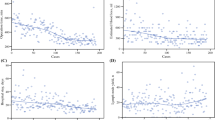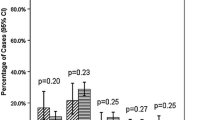Abstract
Background and objectives
Robot-assisted radical cystectomy (RARC) has been shown to be non-inferior to open radical cystectomy (ORC) for the treatment of bladder cancer (BC). However, most data on RARC come from high-volume surgeons at high-volume centers. The objective of the study was to compare perioperative and mid-term oncologic outcomes of RARC versus ORC in a real-life cohort of patients treated by surgeons starting their experience with RARC.
Materials and methods
Data were prospectively collected from consecutive patients undergoing RARC and ORC at five referral Centers between 2010 and 2016 by five surgeons (one per center) with no prior experience in RARC. Patients with high-risk non-muscle-invasive or organ-confined muscle-invasive (T2N0M0) bladder cancer were considered for RARC. The main study endpoints were perioperative outcomes, postoperative surgical complications, and mid-term oncologic outcomes.
Results
Overall, 124 and 118 patients underwent RARC and ORC, respectively. Baseline patients’ and tumors’ characteristics were comparable between the two groups. Yet, the proportion of patients receiving neoadjuvant chemotherapy was significantly higher in the RARC cohort. Median operative time was significantly higher, while median EBL, LOH, and transfusion rates were significantly lower after RARC. Median number of lymph nodes removed was significantly higher after RARC. All other histopathological outcomes, as well as the rate of early (< 30 days) and late postoperative complications, were comparable to ORC. At a median follow-up of 2 years, 29 (23%) and 41 (35%) patients developed disease recurrence (p = 0.05), while 20 (16%) and 37 (31%) died of bladder cancer (p = 0.005) after RARC and ORC, respectively.
Conclusions
With proper patient selection, RARC was non-inferior to ORC throughout the surgeons’ learning phase. Yet, the observed differences in oncologic outcomes suggest selection bias toward adoption of RARC for patients with more favorable disease characteristics.
Similar content being viewed by others
References
Bochner BH, Dalbagni G, Sjoberg DD et al (2015) Comparing open radical cystectomy and robot-assisted laparoscopic radical cystectomy: a randomized clinical trial. Eur Urol 67:1042
Necchi A, Pond GR, Smaldone MC et al (2018) Robot-assisted versus open radical cystectomy in patients receiving perioperative chemotherapy for muscle-invasive bladder cancer: the oncologist’s perspective from a multicentre study. Eur Urol Focus 4:937
Parekh DJ, Reis IM, Castle EP et al (2018) Robot-Assisted Radical Cystectomy Versus Open Radical Cystectomy In Patients With Bladder Cancer (Razor): An Open-Label, Randomised, Phase 3, non-inferiority trial. Lancet 391:2525
Sathianathen NJ, Kalapara A, Frydenberg M et al (2019) Robotic assisted radical cystectomy vs open radical cystectomy: systematic review and meta-analysis. J Urol 201:715
Wilson TG, Guru K, Rosen RC et al (2015) Best practices in robot-assisted radical cystectomy and urinary reconstruction: recommendations of the pasadena consensus panel. Eur Urol 67:363
Hu JC, Chughtai B, O’Malley P et al (2016) Perioperative outcomes, health care costs, and survival after robotic-assisted versus open radical cystectomy: a national comparative effectiveness study. Eur Urol 70:195
Hanna N, Leow JJ, Sun M et al (2018) Comparative effectiveness of robot-assisted vs. open radical cystectomy. Urol Oncol 36:88 e1
Alfred Witjes J, Lebret T, Comperat EM et al (2017) Updated 2016 Eau guidelines on muscle-invasive and metastatic bladder cancer. Eur Urol 71:462
Dagenais J, Bertolo R, Garisto J et al (2019) Variability in partial nephrectomy outcomes: does your surgeon matter? Eur Urol 75:628
Studer UE (2015) The surgeon makes the difference, not the Instrument Used. Eur Urol 67:1051
Raza SJ, Wilson T, Peabody JO et al (2015) Long-term oncologic outcomes following robot-assisted radical cystectomy: results from the international robotic cystectomy consortium. Eur Urol 68:721
Satkunasivam R, Santomauro M, Chopra S et al (2016) Robotic intracorporeal orthotopic neobladder: urodynamic outcomes, urinary function, and health-related quality of life. Eur Urol 69:247
Lenfant L, Verhoest G, Campi R et al (2018) Perioperative outcomes and complications of intracorporeal vs extracorporeal urinary diversion after robot-assisted radical cystectomy for bladder cancer: a real-life, Multi-Institutional French Study. World J Urol 36:1711
Mitropoulos D, Artibani W, Graefen M et al (2012) Reporting and grading of complications after urologic surgical procedures: an ad hoc eau guidelines panel assessment and recommendations. Eur Urol 61:341
Dindo D, Demartines N, Clavien PA (2004) Classification of surgical complications: a new proposal with evaluation in a cohort of 6336 patients and results of a survey. Ann Surg 240:205
Roupret M, Neuzillet Y, Pignot G et al (2018) French ccafu guidelines—update 2018–2020: bladder cancer. Prog Urol 28:S46
Khetrapal P, Kelly JD, Catto JWF et al (2019) Does the robot have a role in radical cystectomy? BJU Int 123:380
Khan MS, Gan C, Ahmed K et al (2016) A single-centre early phase randomised controlled three-arm trial of open, robotic, and laparoscopic radical cystectomy (coral). Eur Urol 69:613
Satkunasivam R, Tallman CT, Taylor JM et al (2018) Robot-assisted radical cystectomy versus open radical cystectomy: a meta-analysis of oncologic, perioperative, and complication-related outcomes. Eur Urol Oncol. https://doi.org/10.1016/j.euo.2018.10.008(epub ahed of print)
Moschini M, Simone G, Stenzl A et al (2016) Critical review of outcomes from radical cystectomy: can complications from radical cystectomy be reduced by surgical volume and robotic surgery? Eur Urol Focus 2:19
Catto JWF, Khetrapal P, Ambler G et al (2018) Robot-assisted radical cystectomy with intracorporeal urinary diversion versus open radical cystectomy (iroc): protocol for a randomised controlled trial with internal feasibility study. BMJ Open 8:e020500
Collins JW, Hosseini A, Adding C et al (2017) Early recurrence patterns following totally intracorporeal robot-assisted radical cystectomy: results from the eau robotic urology section (erus) scientific working group. Eur Urol 71:723
Collins JW, Tyritzis S, Nyberg T et al (2014) Robot-assisted radical cystectomy (rarc) with intracorporeal neobladder—what is the effect of the learning curve on outcomes? BJU Int 113:100
Grande P, Campi R, Roupret M (2018) Relationship of surgeon/hospital volume with outcomes in uro-oncology surgery. Curr Opin Urol 28:251
Williams SB, Ray-Zach MB, Hudgins HK et al (2019) Impact of centralizing care for genitourinary malignancies to high-volume providers: a systematic review. Eur Urol Oncol 3:265–273
Venkatramani V, Parekh DJ (2019) RAZOR trial investigators, evidence trumps consensus. BJU Int. 123(3):374–375. https://doi.org/10.1111/bju.14611
Author information
Authors and Affiliations
Contributions
LL: protocol/project development, data collection or management, data analysis, and manuscript writing/editing. RC: data analysis, and manuscript writing/editing. JP: protocol/project development. VG: data collection or management. AM-L: data collection or management. DV: data collection or management. ALT: protocol/project development. MR: protocol/project development. ML: data collection or management. LT: data collection or management. VM: data collection or management. BG: data analysis. GP: protocol/project development, and data collection or management. CV: protocol/project development. GV: protocol/project development, and manuscript writing/editing. MR: protocol/project development, and manuscript writing/editing.
Corresponding author
Ethics declarations
Conflict of interest
All authors declare that they have no conflict of interest.
Human and animal rights
Formal consent is not required for retrospective study.
Informed consent
Informed consent was obtained from all individual participants included in the study.
Additional information
Publisher's Note
Springer Nature remains neutral with regard to jurisdictional claims in published maps and institutional affiliations.
Rights and permissions
About this article
Cite this article
Lenfant, L., Campi, R., Parra, J. et al. Robotic versus open radical cystectomy throughout the learning phase: insights from a real-life multicenter study. World J Urol 38, 1951–1958 (2020). https://doi.org/10.1007/s00345-019-02998-y
Received:
Accepted:
Published:
Issue Date:
DOI: https://doi.org/10.1007/s00345-019-02998-y




